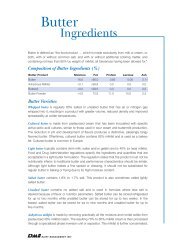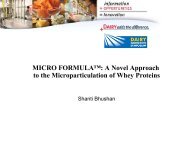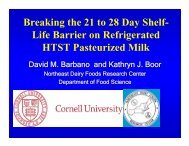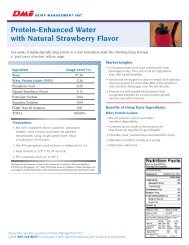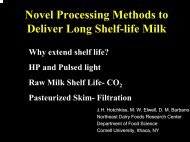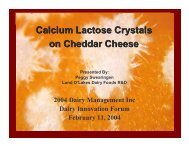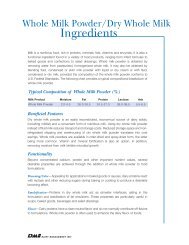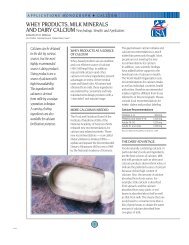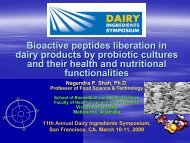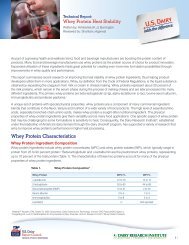Emerging Milk Protein Opportunities - InnovateWithDairy.com
Emerging Milk Protein Opportunities - InnovateWithDairy.com
Emerging Milk Protein Opportunities - InnovateWithDairy.com
You also want an ePaper? Increase the reach of your titles
YUMPU automatically turns print PDFs into web optimized ePapers that Google loves.
Global Demand for Dairy<br />
<strong>Protein</strong> on the Rise<br />
Worldwide, protein consumption is increasing, and there<br />
are multiple reasons for this increase.<br />
As economies create wealth, there is an increased consumption<br />
of animal protein, including dairy, which is a higher-quality protein<br />
than many plant-based protein sources. In developing countries,<br />
protein is used to improve basic nutritional quality for its citizens.<br />
These countries use whey proteins for applications such as infant<br />
formula, canned milk, dairy products and baked goods.<br />
Developed countries seek protein to improve health, wellness<br />
and performance. “These countries are looking for foods that<br />
can deliver specific health benefits,” says Phil Tong, Ph.D.,<br />
director of the Dairy Products Technology Center at California<br />
Polytechnic State University in San Luis Obispo, Calif. “As a<br />
result, the functional food segment of health and wellness foods<br />
has been steadily increasing over the past few years, and whey<br />
protein has be<strong>com</strong>e a choice ingredient for those products.”<br />
According to Mintel International, functional food and beverage<br />
product introductions worldwide grew from 1,566 products in<br />
2005 to 5,753 products in 2009.<br />
More mouths to feed<br />
Population growth worldwide also is a factor in increased<br />
protein demand. In many countries, the population is growing<br />
faster than its own dairy production can handle for the<br />
immediate future, requiring them to find international sources<br />
for dairy protein.<br />
Plus, the growing middle class worldwide will continue to<br />
be a factor in the rising demand for protein. There will be an<br />
estimated additional 800 million middle-class consumers<br />
worldwide by 2030, the majority of that growth <strong>com</strong>ing from<br />
China, India and Southeast Asia, 7 according to research<br />
conducted by Bain & Company on behalf of the Innovation<br />
Center for U.S. Dairy, which is supported and staffed by Dairy<br />
Management Inc. <br />
Functional FUNCTIONAL food FOOD & beverage BEVERAGE INTRODUCTIONS introductions WORLDWIDE worldwide<br />
Number of Product Launches<br />
6000<br />
4000<br />
2000<br />
The growing middle class worldwide<br />
will continue to be a factor in the rising<br />
demand for protein.<br />
“As countries continue to grow and look for ways to improve<br />
the overall health of their citizens, we can expect their demand<br />
for whey protein to increase as well,” says Vikki J. Nicholson,<br />
vice president of U.S. Manufacturing and Ingredients Marketing<br />
at the U.S. Dairy Export Council. “The United States has a great<br />
opportunity to provide a significant portion of the global whey<br />
protein supply.”<br />
Products That Perform:<br />
<strong>Milk</strong> Fractions Help<br />
Manufacturers Develop<br />
Higher-<strong>Protein</strong> Foods<br />
Bland flavor and aroma, excellent foaming characteristics<br />
and low turbidity are just some of the benefits of whey proteins<br />
derived directly from milk, appealing to makers of proteinenhanced<br />
food and beverage products, according to researchers<br />
at the Wisconsin Center for Dairy Research (WCDR), located at<br />
the University of Wisconsin-Madison.<br />
“Whey proteins derived directly from milk are new-generation<br />
dairy ingredients that hold great potential for foods and<br />
beverages formulated with high concentrations of protein,” says<br />
K.J. Burrington, coordinator of the Dairy Ingredients Applications<br />
Laboratory at the WCDR. “Promising applications include sports<br />
and nutritional bars and beverages, baked goods, whipped<br />
confectionery items and snack foods.”<br />
The key attributes of whey proteins derived directly from milk<br />
<strong>com</strong>e from the nature of the production process. The end<br />
product is more consistent because it has not undergone the<br />
cheesemaking process, which inherently adds certain variables,<br />
such as differing cheese types, rennet enzyme, colors and starter<br />
cultures. In addition, the process of fractionating whey proteins<br />
directly from milk requires fewer heat pasteurization steps, which<br />
reduces protein denaturation and preserves product solubility.<br />
0<br />
2005 2006 2007 2008 2009<br />
Source: Mintel GNPD<br />
7<br />
Bain & Company, Dairy Globalization – Threats, <strong>Opportunities</strong> and Implications, 2009. Research<br />
conducted in association with the Innovation Center for U.S. Dairy’s Globalization Task Force.<br />
2 <strong>Milk</strong> <strong>Protein</strong> Fractionation<br />
<strong>Opportunities</strong>



